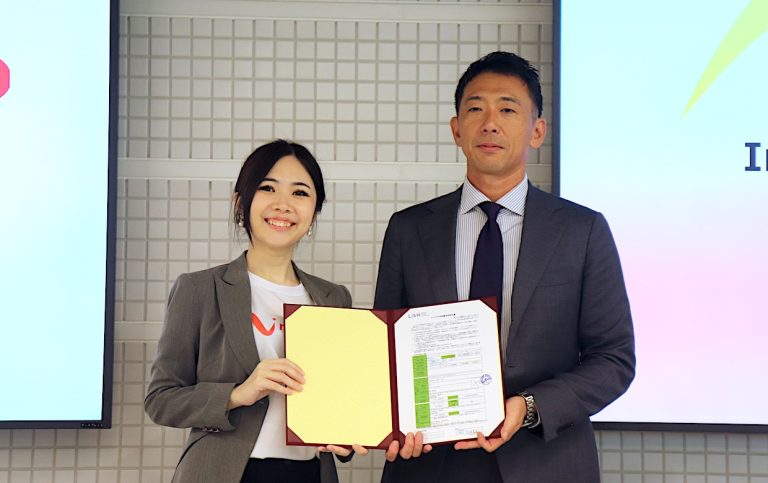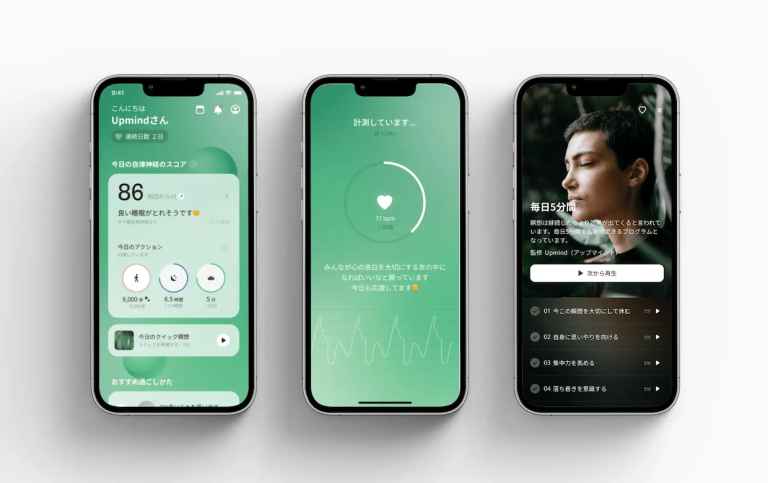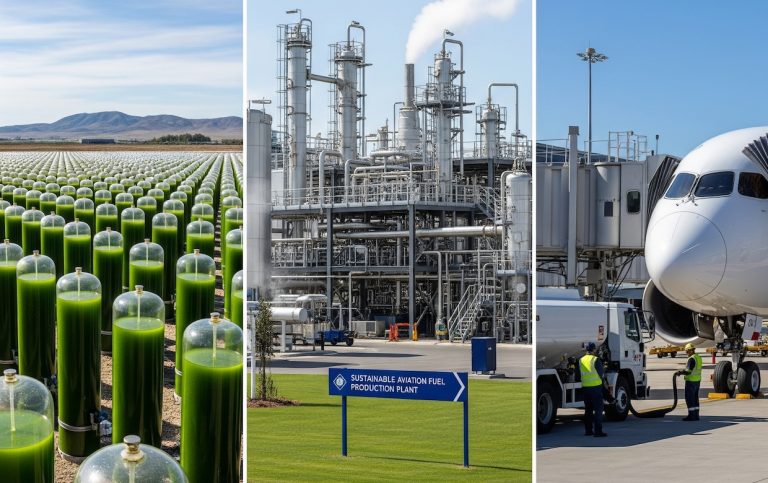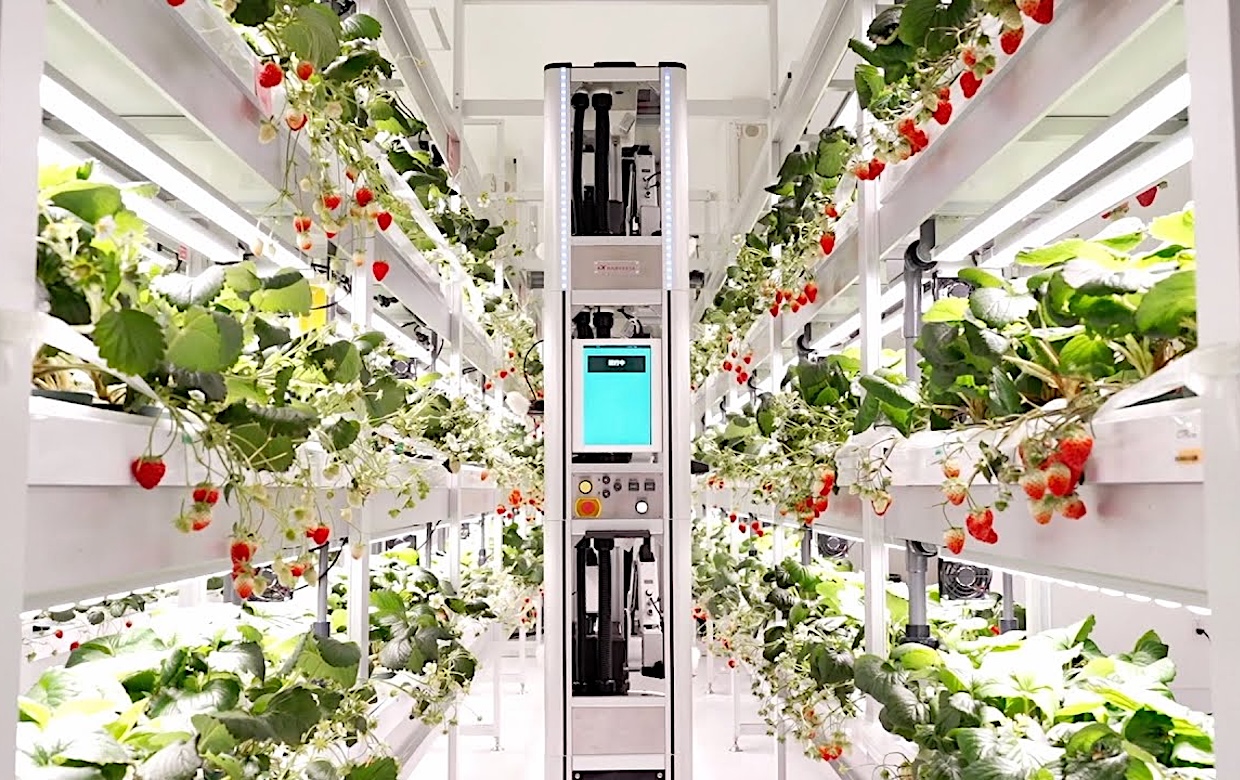
In a repurposed former department store site in Japan’s central city of Hamamatsu, box-shaped robots glide silently between rows of lush strawberry plants illuminated by artificial light. With recent updates enabling fully autonomous operation, these machines methodically select flowers and perform pollination tasks completely independently. What once required several workers an entire day to complete is now finished in just a few hours—a glimpse into the future of agriculture.
Founded in 2020, HarvestX provides plant factory solutions that leverage robotics and AI to achieve stable strawberry production and reduce cultivation costs. The company’s XV3 pollination robot has achieved the world’s first complete automation of strawberry pollination—a task traditionally performed by honeybees. This breakthrough technology offers new solutions to fundamental challenges facing modern agriculture, from food security to climate change.
The company’s technological superiority is demonstrated through striking metrics. While honeybee pollination achieves approximately 70% success rates, HarvestX’s robotic system reaches 90% precision—representing far more than mere mechanical substitution.
In November 2024, HarvestX announced its first commercial deployment with Shunkado, the Hamamatsu confectionery company famous for its “Unagi Pie” eel pastries. This milestone marked the completion of a four-year journey from technical development to practical implementation. Hamamatsu Farm, the company’s pilot plant, now operates with an annual production capacity of up to 5,400 kilograms, fielding inquiries from around the globe. Remarkably, approximately half of these inquiries originate overseas, demonstrating the global potential of this technology.
From University Lab to Agricultural Innovation
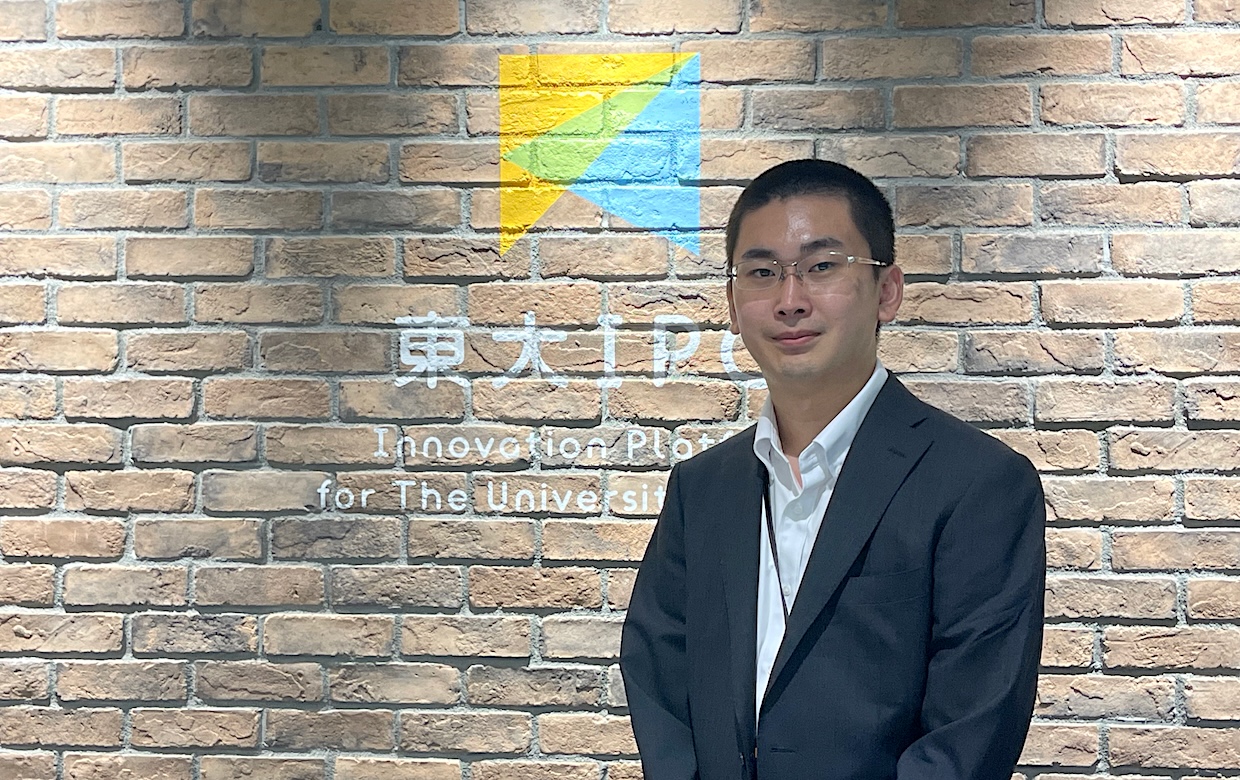
HarvestX CEO Yuki Ichikawa was born in Hamamatsu in 1997. While studying information engineering at Chiba Institute of Technology, he already operated as a freelance embedded engineer for electronics manufacturers and startups. However, his transition from purely technical pursuits to social implementation began with his participation in projects at the University of Tokyo’s Hongo Tech Garage.
Initially, I was simply passionate about building things—somewhat isolated in my own world, creating what I wanted to make. But coming to the University of Tokyo and observing other projects, I realized that beyond developing good technology, everyone was grappling with how to apply it in society. I began thinking about how to implement the technologies I developed for social benefit. (Ichikawa)
His exposure to agriculture came through participation in a wine grape sensing project led by a University of Tokyo agriculture researcher. This experience revealed agriculture’s depth and potential. He became convinced that applying data science and robotics could create more scientific and reproducible farming methods, moving beyond traditional experience-based approaches.
Strawberries captured his attention precisely because they presented ideal challenges for AI and machine learning. Unlike the standardized components that industrial robots typically handle, each strawberry possesses unique shape and color characteristics. Ichikawa recognized this diversity as the perfect domain for machine learning and deep learning technologies to demonstrate their true capabilities.
Agriculture is a fascinating field, but much of it still relies heavily on experience, with many aspects not yet systematized or quantified. This made it extremely attractive as an application area for my robotics expertise. (Ichikawa)
The company’s incorporation in August 2020 followed participation in the University of Tokyo IPC 1stRound program, securing initial investments from ANRI and DEEPCORE. While Ichikawa had originally planned to pursue traditional employment, his commitment to technology implementation and encouragement from mentors led him toward entrepreneurship.
Crisis of Bee-Dependent Agriculture
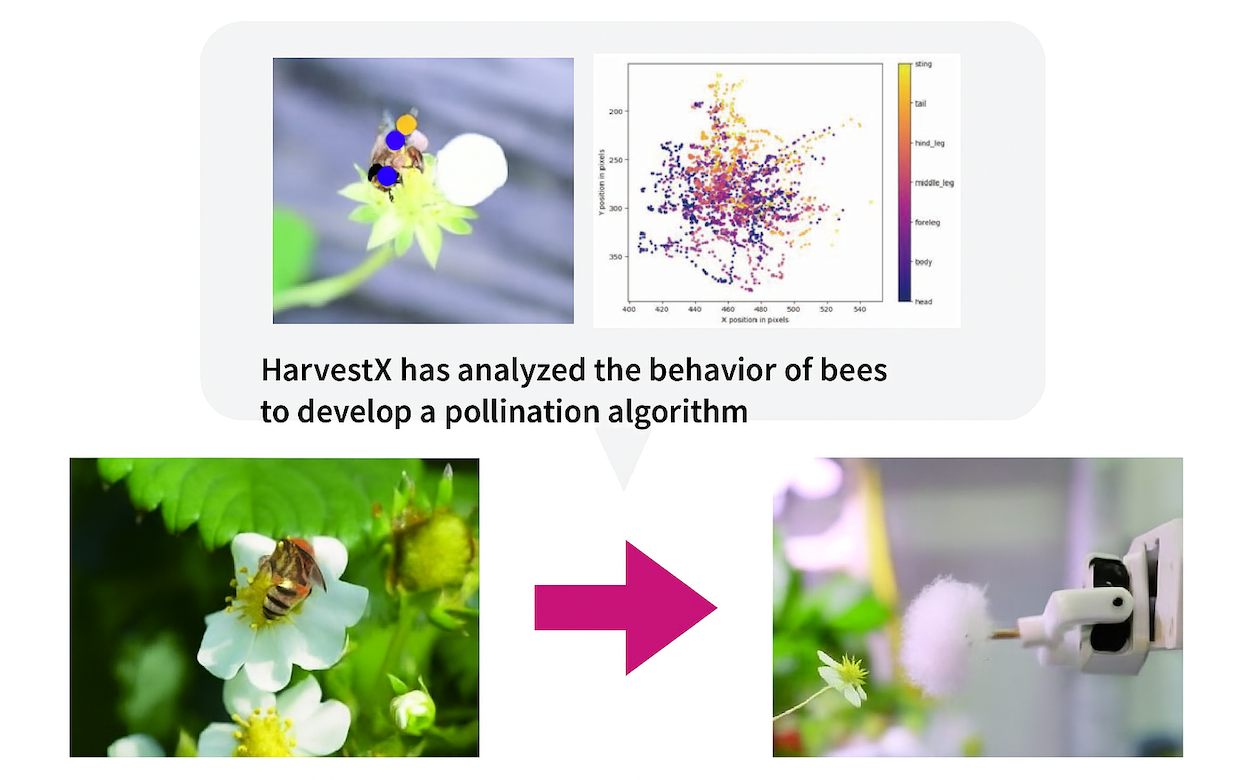
Modern strawberry cultivation faces complex and severe challenges, with the decline of honeybees essential for pollination and climate change impacts representing the most pressing issues. Rising temperatures have reduced bee populations while drastically decreasing the number of beekeepers. Bee shipments have become constrained, creating situations where the basic means of pollination is simply unavailable.
Initially, we heard many voices saying “automated pollination is unnecessary—bees work fine.” However, the situation has changed dramatically over the past 2-3 years. Temperature increases and declining bee populations mean that beekeepers have largely disappeared, and bee shipments are now heavily restricted. Farmers are struggling with the fundamental challenge of securing pollination methods. (Ichikawa)
Approximately 85-90% of tomatoes and strawberries in circulation are produced through greenhouse cultivation, indicating these crops have already transitioned to industrial production systems with significant potential for further automation. However, strawberry cultivation in plant factories has been considered extremely technically challenging, with completely different difficulty levels compared to leafy vegetables, leading many companies to attempt and subsequently abandon such efforts.
Ichikawa initially faced these same challenges when attempting to introduce robots into conventional farms. Variations in aisle widths between farms, uneven and bumpy ground surfaces, and solar interference affecting sensors created too many environmental variables for robots to operate stably.
This experience led HarvestX to adopt a distinctive approach: rather than solely improving robot performance, they focused on optimizing the cultivation environment itself.
Rather than making robots increasingly sophisticated, I believe creating environments where robots can operate stably is more critical for real-world implementation. This is why our company, which began with robots and AI, now also develops cultivation equipment. (Ichikawa)
This strategic pivot has enabled HarvestX to register as a seedling supplier and now offer comprehensive “corporate strawberry cultivation kits” including seedling provision, daily operation manuals, cloud-based production management systems, and cultivation equipment.
Robot Pollination Through Vertical Integration
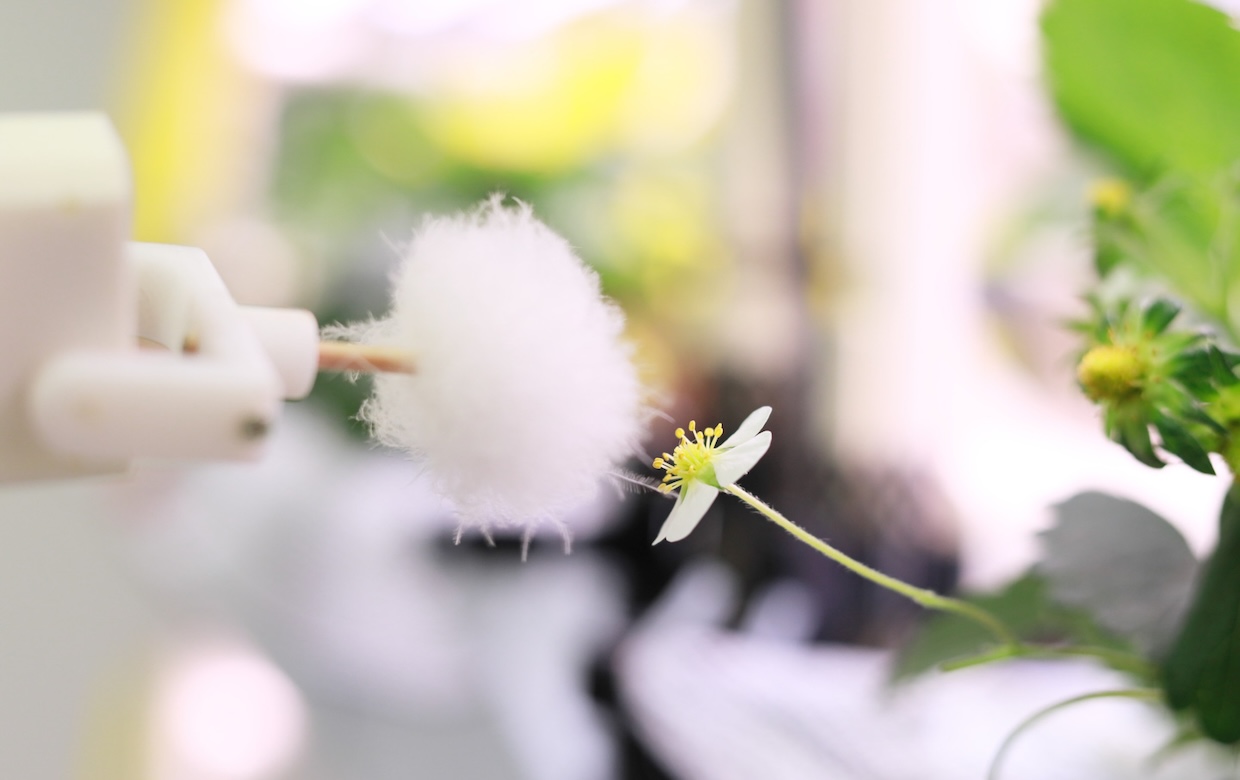
HarvestX’s technological advantages extend far beyond simple mechanical automation of pollination tasks. The company has developed pollination technology that mimics bee behavior, conducting detailed analysis of movement patterns from bees that have coevolved with plants since ancient times and applying these insights to robotic control.
Pollination work proves far more delicate and complex than it appears. Damaging flowers prevents fruit formation, so excessive force must be avoided. However, insufficient contact fails to transfer pollen, preventing proper fruit formation. With strawberries particularly, pollen distribution patterns directly affect fruit shape, requiring perfect balance.
Pollination appears simple, but damaging flowers prevents fruit formation. Gentle contact alone is insufficient, while excessive force causes damage. Strawberries are especially sensitive because pollen distribution affects fruit shape, making uniform pollination across the entire flower crucial—requiring an exquisite balance. (Ichikawa)
To achieve this delicate balance, HarvestX employs vertical integration, developing everything in-house from hardware mechanical design through firmware, middleware, and AI models.
We vertically integrate everything from hardware design through firmware, middleware, and AI models. Beyond field knowledge and engineering perspectives, we need botanical insights—understanding when flowers bloom and when pollen transfers most effectively. Achieving high precision across these interdisciplinary domains represents our greatest challenge. (Ichikawa)
The pollination tools resemble traditional “bonten” (fluffy applicators) but incorporate proprietary materials that enhance pollination success rates. This technology enables robots to complete in just hours what traditionally required multiple workers an entire day. AI-powered image recognition assesses flower conditions to determine optimal pollination timing and intensity through complex algorithms, achieving 20% higher precision than honeybees.
Building Data-Driven Competitive Advantages
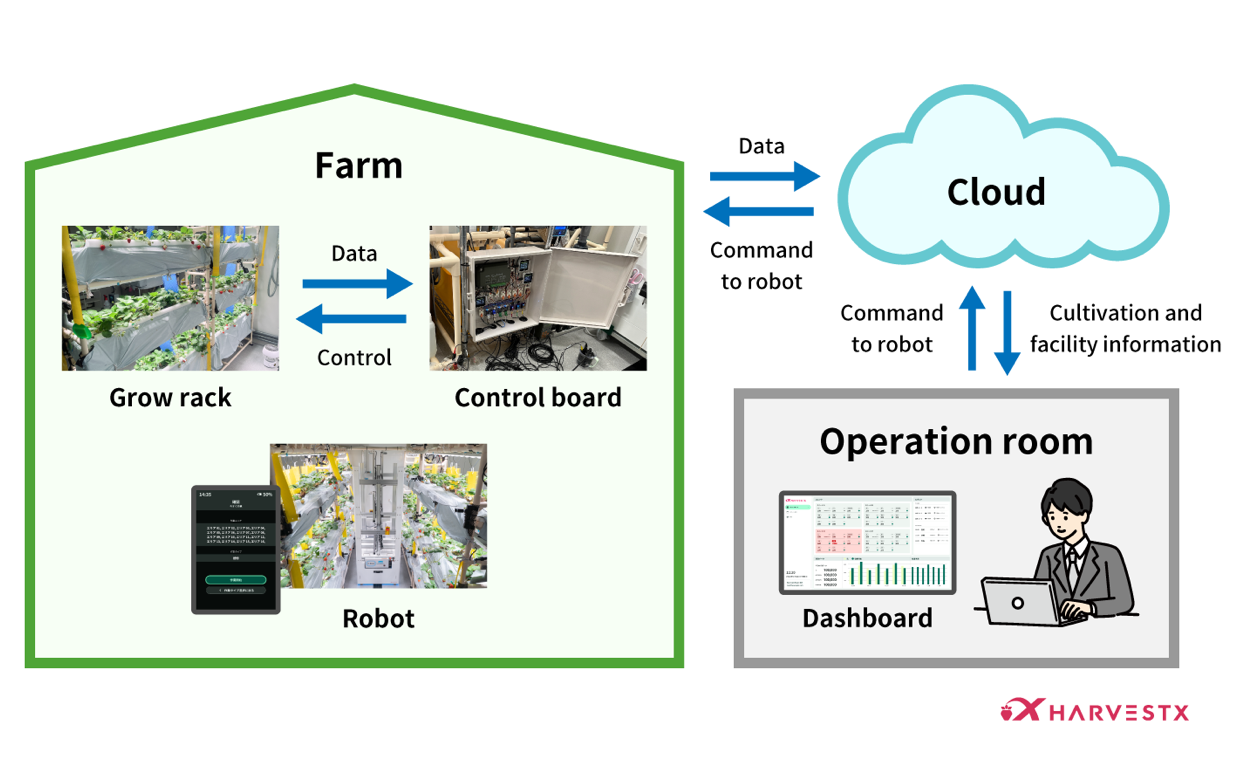
HarvestX’s true competitive advantage lies not only in technology but in continuously accumulated high-quality data. By entering the market through pollination services, the company has established systems for collecting detailed daily data throughout strawberry growth cycles.
Data volume represents our greatest strength. Since we entered through pollination, all daily data collection feeds into our database. In plant factory controlled environments, we capture highly reproducible information about cultivation conditions and outcomes. We have internal systems for gathering this data and analyzing it to continuously develop new models. (Ichikawa)
With customer permission, operational data from client facilities also feeds into analysis for next-generation technology development, creating feedback loops. This enables the company to maintain diverse, large-scale datasets impossible to obtain through individual experiments, building technological moats that competitors cannot easily replicate.
This approach avoids the investment inefficiencies that have trapped past startups. Traditional models requiring self-built facilities could cost billions of yen (tens of millions of dollars) with annual capacity for only 2-3 new facilities. HarvestX instead provides systems to customers whose facilities scale exponentially, simultaneously achieving data accumulation and business expansion.
The revenue model also shifts from traditional sales to subscription-based service provision. Offering robots as pollination services reduces initial investments while securing continuous revenue streams, achieving cost-effectiveness equal to or superior to bee-based pollination.
Local Ecosystem Drives Commercial Success
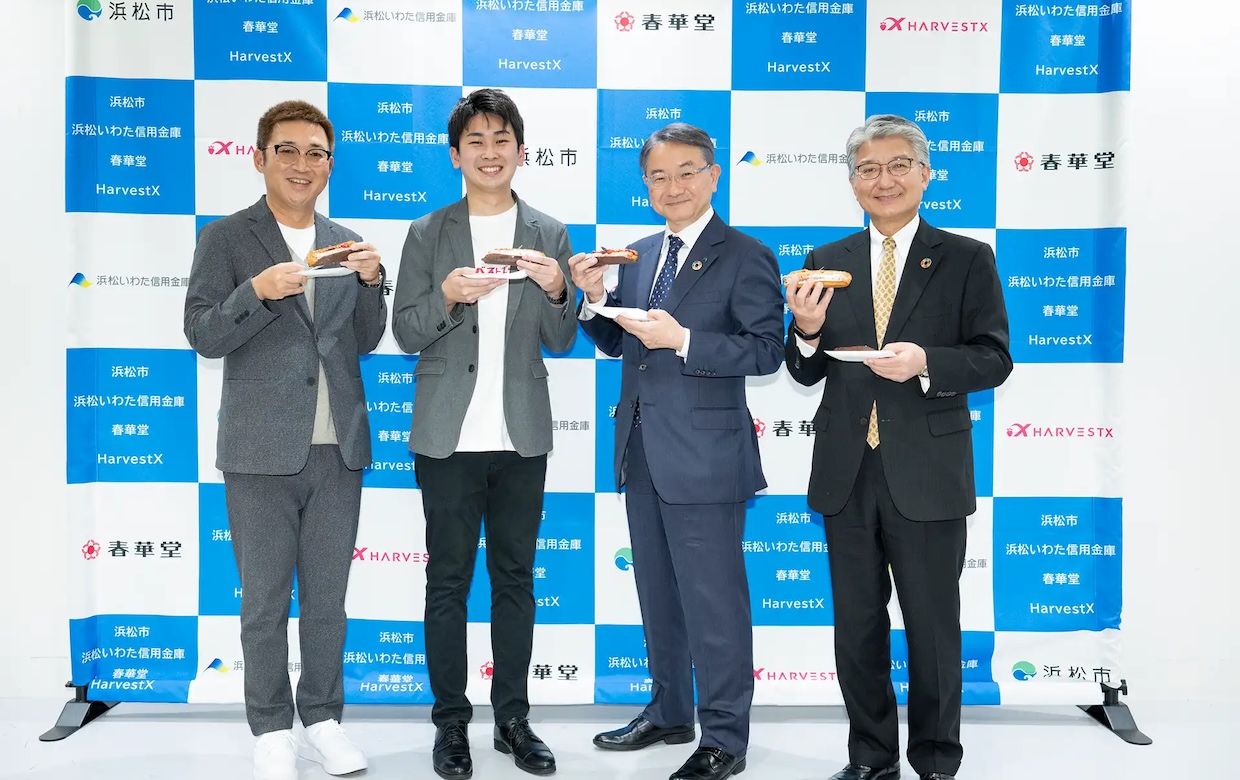
Photo credit: HarvestX
In November 2024, HarvestX announced its first commercial deployment with Hamamatsu’s Shunkado confectionery company. This success reflects not only technological capabilities but the effective functioning of regional innovation ecosystems.
Ichikawa’s hometown of Hamamatsu has aggressively pursued startup support under Yasutomo Suzuki (former mayor, now Shizuoka Prefecture governor), with industry-academia-government collaboration mechanisms powerfully supporting HarvestX’s business development.
Initial support came from Hamamatsu Iwata Shinkin Bank, a local financial institution. For our next milestone, we needed to demonstrate large-scale implementation capabilities at our own facility, and Hamamatsu emerged as a candidate location. (Ichikawa)
Hamamatsu’s “Fund Support Program” provides 40-50 million yen (approximately $270,000-$340,000) grants to companies receiving investments from city-certified VCs. Additionally, the city provided human resources support for navigating plant factory regulatory compliance through close administrative collaboration.
Shunkado’s adoption decision centered on the alignment between customer needs and technological capabilities. Shunkado President Takahiro Yamazaki noted: “Strawberry distribution volumes fluctuate seasonally. Plant factories that operate independently of natural environments, producing stable, high-quality strawberries year-round, represent significant progress for the confectionery industry.”
Food manufacturing industry-specific benefits also proved crucial. Industries requiring minimal contamination risk find traditional bee or fly-based pollination methods unsuitable. Mechanization enables more hygienic production environments, delivering substantial added value.
Learning from Past Plant Factory Failures
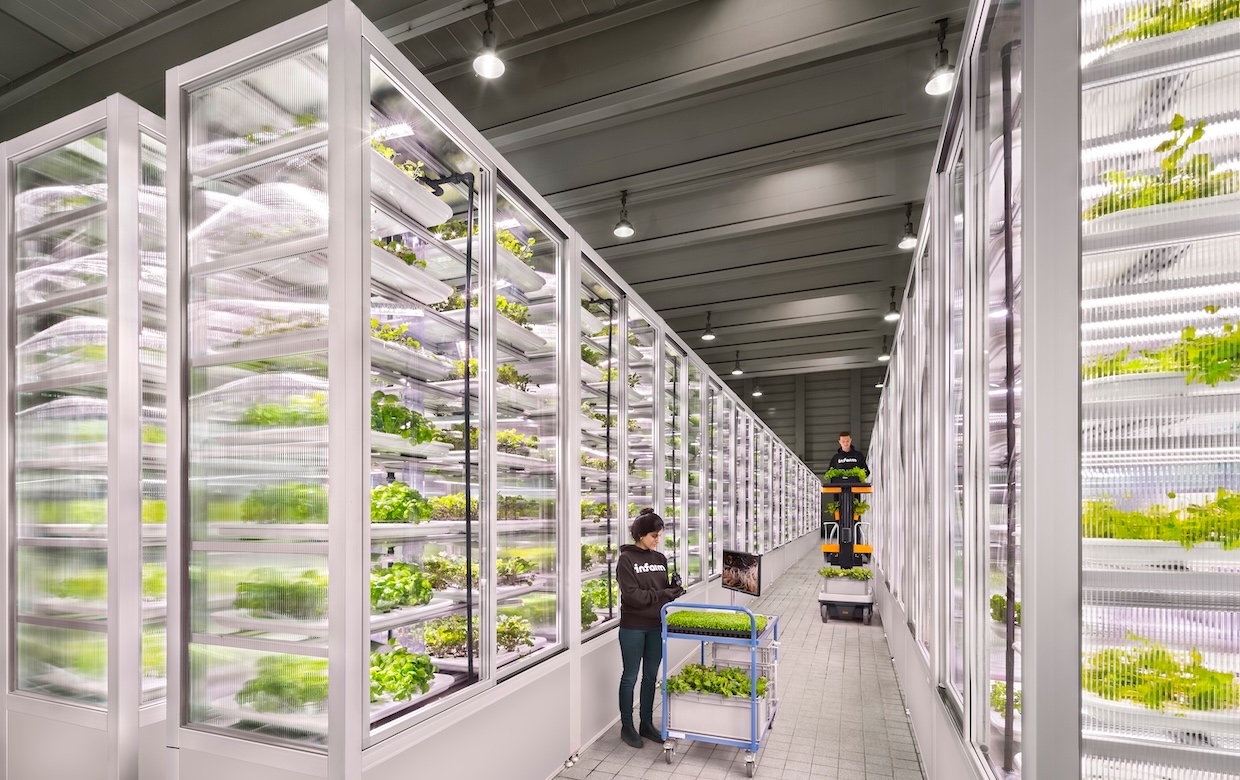
Photo credit: Infarm
Plant factories have experienced multiple boom cycles, but many companies have subsequently withdrawn. While the 2022 fully artificial light plant factory market reached 28.1 billion yen (approximately $190 million), approximately 30% of leafy vegetable plant factories achieve profitability while 70% remain unprofitable.
Ichikawa clearly analyzes failure factors. During the 2000s plant factory boom, many companies began leafy vegetable production using available spaces but without securing sales channels. The “let’s try production first” mentality resulted in disposal costs for unsold products, creating double cost burdens leading to losses.
Conversely, profitable companies typically represent food manufacturers and similar businesses with internal consumption channels. HarvestX’s customer strategy applies these lessons, with most inquiries coming from companies already using strawberry products internally—food manufacturers, real estate developers, railway companies, and others with established internal sales channels.
The economic rationale for selecting strawberries is clear. According to Ministry of Agriculture statistics, strawberries represent a 177.4 billion yen (approximately $1.2 billion) domestic market, second only to tomatoes at 236.7 billion yen (approximately $1.6 billion), with significant unit price advantages.
The biggest difference between strawberries and leafy vegetables is unit price. Lettuce sells for just a few hundred yen (approximately $2-3) per kilogram, while strawberries command 1,700 to 2,700 yen (approximately $11-18) per kilogram at wholesale markets—more than a 10-fold difference. (Ichikawa)
For global expansion, competitive advantages remain crucial. Major overseas companies like Plenty that attempted transitions from leafy vegetables to fruit vegetables ultimately failed and entered civil rehabilitation. Companies successfully achieving both pollination stabilization and large-scale cultivation scalability remain countable on one hand worldwide.
Future of Sustainable Agriculture
Approximately half of HarvestX’s current inquiries originate overseas, demonstrating strong global market demand. Geographically, inquiries arrive from all regions except Africa, spanning Southeast Asia, the Middle East, North America, and Europe across diverse industries beyond agriculture.
We receive requests worldwide, including from startups saying ‘We tried strawberry cultivation but couldn’t succeed.’ We get consultations ranging from robot-only exports to full package implementations for restaurants wanting to use Japanese-quality strawberries. (Ichikawa)
Interestingly, overseas strawberry consumption actually exceeds Japan’s. However, unlike Japan’s fresh consumption patterns, overseas markets primarily use strawberries for yogurt mixing, jam processing, and other applications.
The company’s open-source strategy serves both social contribution and strategic talent acquisition purposes. Particularly overseas, open-source initiatives frequently lead to recruitment opportunities.
We share common components to avoid reinventing the wheel—this serves both social contribution and strategic talent acquisition. Open-source initiatives, especially overseas, very frequently connect to recruitment.
While we open-source robot arms and sensor components, recreating our complete robots would be difficult since it requires different connecting parts, packages, and know-how that make replicating our full solutions technically challenging. (Ichikawa)
HarvestX’s current team of approximately 20 people consists of 90% researchers and engineers, including agricultural specialists providing multidisciplinary expertise for technology development. While currently focused on strawberries, the company envisions future expansion to tomatoes, melons, and other fruit vegetables requiring pollination.
Our business characteristics make collaboration with various companies relatively easy. Since robots require semiconductors and communications, partnering with companies providing those services creates mutual benefits. (Ichikawa)
HarvestX aims beyond simple profitability toward sustainable agricultural systems. The company mission “Abundant food for future generations” represents sincere commitment to addressing fundamental challenges in current food production systems.
Of course, we must pursue maximum returns for investors, but we can simultaneously improve society. As a for-profit enterprise, we cannot continue services without profitability, which ultimately disserves customers. Solving social problems enables us to return value to investors. (Ichikawa)
Japan’s food self-sufficiency rate by production value fell to 63% in 2021, declining 4 points to reach historic lows according to Ministry of Agriculture statistics. Establishing stable food production systems independent of climate variations has become urgent.
Currently, we’re intensely focused on global expansion. While abundant funding would be welcome, partnerships matter even more. Rather than building sales organizations from scratch, we want to actively leverage assets that major companies already possess. (Ichikawa)
HarvestX’s journey from founding to commercialization in just four years, its technological depth as a University of Tokyo spinoff, and business development leveraging Hamamatsu’s regional ecosystem present new success models for Japanese deep-tech startups. As climate change pushes conventional agriculture to its limits, high-precision food production in controlled plant factory environments becomes essential for human food security.
HarvestX’s business model avoids the heavy equipment investments that typically burden agricultural ventures, instead creating lightweight business structures centered on technology and data. The virtuous cycle where customer facilities continuously accumulate data that feeds new technology development builds sustainable competitive advantages that competitors cannot easily replicate. As demonstrated by global inquiries, HarvestX’s technology holds potential as a crucial piece in solving planetary food challenges.





